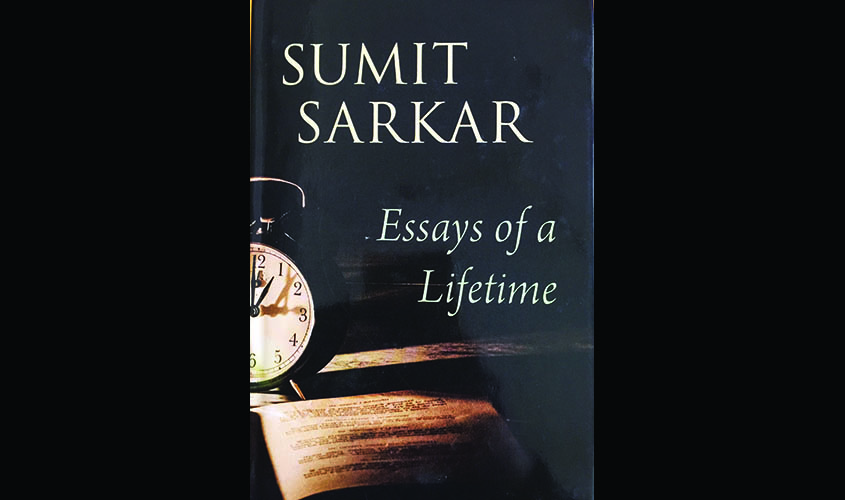The best of histories are written in worst of times. Distinguished scholars rise above aggressive political propaganda to produce historical works providing critical insights on what happened in the past—some lessons from which can shape the present. One such historian, the much admired Professor Sumit Sarkar has devoted his life working with just one agenda—scholarly excellence. In doing so, he has questioned received wisdom, pushed disciplinary boundaries, and set high standards of critical historical scholarship, some samples of which can be savoured in his recently published book, Essays of a Lifetime: Reformers, Nationalists, Subalterns (Permanent Black).
Spread over 640 pages, the book is divided into three sections. The first part comprising eight chapters offers a detailed critique of contradictory pulls of social reform and religious revival in colonial Bengal. Humiliation of colonial subjugation was to be balanced with glorification of India’s ancient past and attack on the so-called tyranny of Muslim rule before the British conquest. This meant even the most sincere of reform efforts falling prey to what was subsequently identified as the infamous divide-and-rule policy of the British, besides capitulating to contradictions between traditional norms and modern transformations. The second set of six chapters further reveals Sarkar’s longstanding scholarly investment in various strands of subaltern activism and nationalist interventions, as the foremost scholar of Swadeshi movement with a lapsed association with critical Subaltern Studies scholarship of 1980s and 1990s. The third section offers tributes to scholar-activists P.C. Joshi, Eric Hobsbawm and E.P. Thompson, with Sarkar acknowledging his intellectual debt especially to the latter.
Some of the themes and issues of crucial import to the history of Bengal and by extension of rest of India may be highlighted here. In a provocative opening chapter in which conclusions are offered upfront, Sarkar points out that Rammohan Roy’s writings and activities signify a break with tradition, but a close investigation of the precise extent and nature of the departure reveals it was constrained by a Hindu-elitist and colonial framework. The much touted Bengal renaissance, therefore, was an intellectual movement of a “false consciousness of pathetic kind”, which was bred by colonialism. Beyond laudatory rhetoric, it did not lead to basic social transformation in a progressive direction in Bengal’s development, which, indeed, saw a break from the level-playing field of early modern to the full blast of colonial modern exploitation. The march to modernity eventually slid into conformity to caste rules and other deeply flawed actions revealing contradictions in theory and practice.
In Sarkar’s analysis, the myth of the renaissance and awakening presupposed a dark age. Accordingly, the reformists converged on “all-pervading assumption that British rule had been preceded by centuries of Muslim tyranny and therefore had to be welcomed as a deliverance from an age of darkness”. A host of conservatives and progressives alike suffered from this “ubiquitous syndrome” throughout 19th-century Bengal. This was bound to snowball into a communal conflagration and divide in decades to come. The interesting “sequence of significant effort and ultimate failure”, often returning to status quo ante, though sometimes lasting shifts as well, has been studied by Sarkar further with reference to political domain, especially the “zig-zag pattern of nationalist activity” in Bengal. The failure of both radical intellectual heroes and much exploited peasant rebels indicates the specific ways in which colonial situation warped, hindered, or frustrated legitimate aspirations.
Sarkar also presents a complex picture of the caste question. Marginalised, but increasingly assertive, communities such as Namsudras, Mahishyas and Rajbanshis deployed their own vernacular histories articulating their identities and seeking higher status in society. The two registers of caste and class defused any possibility of a broad plank for transformative politics. Further, in Sarkar’s opinion, solidarities based on nation, region, religion or community, class, caste, tribe or women are unable to sustain themselves beyond a point—making identities around them fluid and transient with multiple possibilities.
Working from within the emerging Hindu fold, Ramakrishna Paramahansa (1836-1886) warned his followers against falling in the usual trap of lust and greed which forced them to endure the humiliation of colonial government employment (the troika of kamini, kanchan, and chakri), resembling conditions of Kaliyuga. Sarkar quotes Ramakrishna Kathamrita in which the saint articulated the catholicity of inclusive Hinduism, recognising many separate ways to achieve the same goal: “There is a pond with three or four ghats—Hindus call what they drink jal, Muslims pani, the English water. He is called Allah by one, God by others, some say Brahma, others Kali, still others Ram, Hari, Jesus, or Durga.” The Bengali bhadralok’s urbanity was carefully shaped in the 19th century by this kind of intelligent mix of tradition and modernity, aimed at transcending narrow limits of caste and religion based prejudices. Sarkar offers interesting insights on all these important issues.

